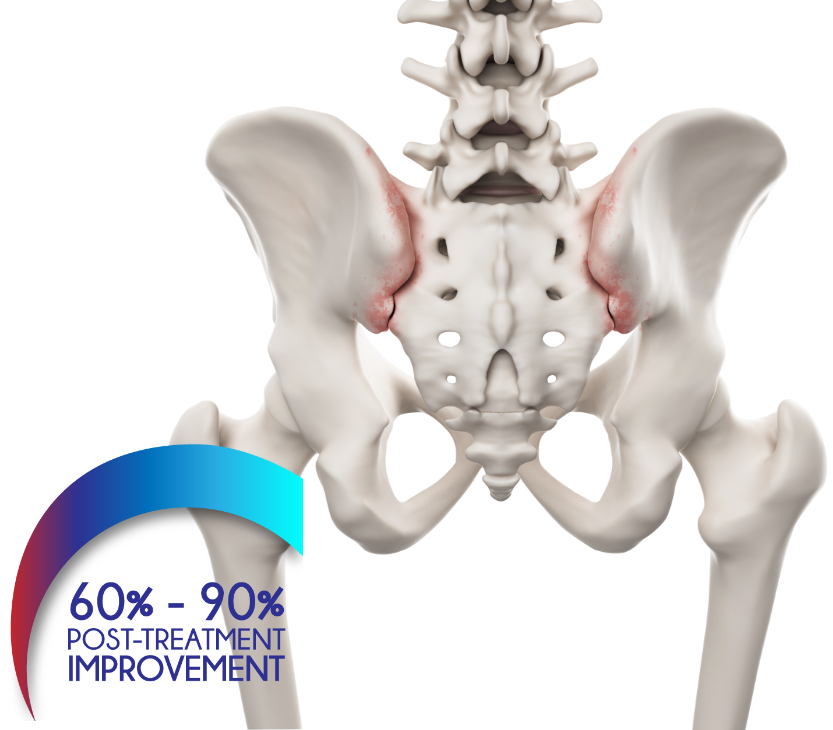Back Pain
SACROILLIAC JOINT DYSFUNCTION
Causes, Symptoms
and Treatments.
What is it?
Sacroiliac joint dysfunction is the inflammation of either or both sides of the sacroiliac joints, i.e., the joints connecting the lower spine to the pelvis. It causes lower back pain that extends down the buttocks and one or both legs.
COMMON CAUSES
Sacroiliac joint dysfunction can happen due to several underlying causes, such as traumatic injuries, arthritis, and infections. Injuries caused by accidents and severe falls can damage the sacroiliac joints, leading to immense pain. The gradual wear-and-tear of the cartilage (osteoarthritis) between the sacroiliac joints may also cause severe joint pains due to friction. And pregnancy increases the risk of sacroiliac joint dysfunction due to the added weight and stress on the joints.
MAIN SYMPTOMS
Sacroiliac joint dysfunction’s immediate symptom is a pain in the lower back and buttocks, which eventually affects the groin and passes down one or both legs, eventually reaching the feet. Sacroiliac joint pains worsen when you stand still for extended periods, stand with more weight on one leg than the other, climb stairs, run, or take large strides. If left untreated, sacroiliac joint pains progress considerably, leading to mobility issues and insomnia.ts.
Call us or submit this form to make a back pain appointment!
Your information is encrypted and secure. By registering you confirm that you accept Terms and Conditions and Privacy Policy
SACROILLIAC JOINT DYSFUNCTION
TREATMENT
S. J. DYSFUNCTION TREATMENT
EPIDURAL INJECTIONS
Epidural steroid injections deliver cortisone steroids into the epidural space of your sacroiliac joints to reduce the inflammation and pain. By minimizing the inflammation around the nerve roots, the corticosteroids improve your leg and back mobility, allowing you to resume most daily activities. While epidural steroid injections provide immediate relief, you must also continue physical therapy for sustained and long-term relief.
PHYSICAL THERAPY
Physical therapy is the first line of defense against most spinal pain problems, including sacroiliac joint dysfunction. Your physical therapist guides you through numerous range-of-motion exercises to strengthen your muscle, increase flexibility, and improve your mobility in the affected regions. Consistent physical therapy can minimize the pain caused by damaged sacroiliac joints.
RADIOFREQUENCY DENERVATION
Radiofrequency denervation is a minimally invasive procedure used to treat inflamed or damaged joints. The procedure involves injecting local anesthesia into the specifically-targeted nerves responsible for carrying pain impulses from your sacroiliac joints to your brain, preventing you from experiencing pain.
RADIOFREQUENCY DENERVATION
Radiofrequency denervation is a minimally invasive procedure used to treat inflamed or damaged joints. The procedure involves injecting local anesthesia into the specifically-targeted nerves responsible for carrying pain impulses from your sacroiliac joints to your brain, preventing you from experiencing pain.

WHAT TO EXPECT AFTER
S. J. DYSFUNCTION TREATMENT
POST-TREATMENT IMPROVEMENT
Sacroiliac joint dysfunction is treated with non-invasive or minimally-invasive procedures performed on an outpatient basis. Epidural steroid injections and radiofrequency denervation provide immediate relief, but they must be followed with regular physical therapy. Before you leave the clinic, you’ll be given a detailed set of post-treatment recovery instructions, guidelines, and activity limitations. You must follow all the guidelines and continue your physical therapy to improve your joint mobility and ensure long-term pain relief.
Do you have any symptoms? CALL US NOW
Will your health insurance cover your pain treatment?
Most pain treatments are covered by most health insurances, including medicare. Our insurance specialists are available to discuss your options call us to get started at (866) 446-0946 or fill out the form below:
